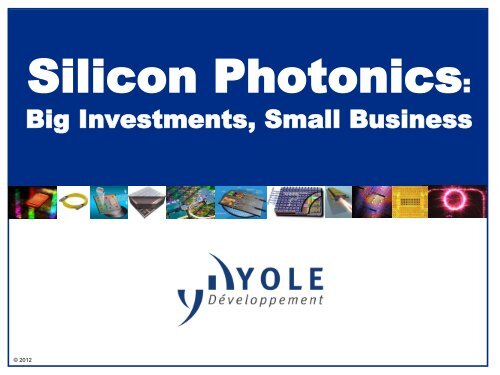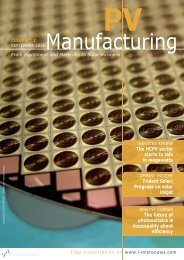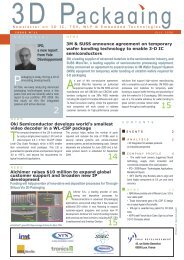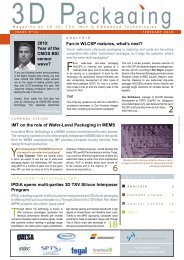Download sample - I-Micronews
Download sample - I-Micronews
Download sample - I-Micronews
You also want an ePaper? Increase the reach of your titles
YUMPU automatically turns print PDFs into web optimized ePapers that Google loves.
Silicon Photonics:<br />
Big Investments, Small Business<br />
© 2012
© 2012 • 2<br />
Report Content<br />
• Table of Content … 3<br />
• Companies listed in the report … 5<br />
• What’s inside the report, what’s not … 6<br />
• Executive Summary … 7<br />
– The (few) key facts to remember about silicon photonics … 8<br />
– Silicon photonics definition … 11<br />
– Silicon photonics market … 12<br />
– Silicon photonics advantages … 13<br />
– Silicon photonics time-to-market … 14<br />
– Inflection points for silicon photonics … 15<br />
– Silicon photonics devices … 16<br />
– Silicon photonics application revenues … 17<br />
– Silicon photonics dies market forecast … 18<br />
– Silicon photonics wafer forecast … 19<br />
– Why silicon photonics only in AOCs today … 20<br />
– Technical challenges … 21<br />
• Introduction … 22<br />
– Silicon photonics definition … 23<br />
– Focus on III-V integrated photonics … 27<br />
– Focus on silicon photonics … 36<br />
• Industry driving forces … 43<br />
– Roadmaps … 44<br />
– Datacom protocols roadmap … 50<br />
• Applications … 56<br />
– Applications summary … 57<br />
– Telecom … 66<br />
– Datacom … 71<br />
– HPC & Data Centers … 75<br />
– Consumer … 89<br />
– Others (Military/Aerospace/Medical) … 92<br />
• Market forecast … 97<br />
– Silicon photonics TAM … 98<br />
– Optical components market forecast … 99<br />
– Silicon photonics applications revenues 2010-2017 … 102<br />
– Silicon photonics 2012 revenues by application … 103<br />
– Silicon photonics 2017 revenues by application … 104<br />
– Active vs. passive silicon photonics revenues 2010-2017 … 105<br />
– Silicon photonics products breakdown … 108<br />
– Silicon photonics dies market forecast … 111<br />
– Silicon photonics wafer forecast … 112<br />
– Estimated 2011 market share … 113<br />
• Silicon photonics players … 114<br />
– Evolution of the business model … 115<br />
– Silicon photonics foundries … 118<br />
• Financial analysis … 121<br />
– Raised funds by company … 123<br />
– Relative investment efficiency … 125<br />
• The different manufacturing approaches … 126<br />
– Photonic in standard CMOS … 127<br />
– Laser sources vs. VCSELs … 133<br />
– The different approaches to Si photonics integration … 135<br />
– The different bonding technologies … 142<br />
– Design & packaging issues … 149<br />
– A new approach: 2.5 and 3D … 152<br />
• The integrated photonics « building blocks » … 157<br />
– Summary … 158<br />
– Light sources … 163<br />
– Modulators … 168<br />
– Detectors … 173<br />
– Mux/Demux … 176<br />
– Couplers … 178<br />
– Passive devices … 181<br />
– Others … 181<br />
• Conclusions … 183<br />
• 20+ Company Profiles … 186<br />
• Appendix … 212<br />
• Yole Développement presentation … 213
What is inside this report, what is not<br />
• In this report, Yole is investigating primarily active silicon photonic devices:<br />
– Lasers, detectors, VOAs, optical switches other active elements that have an electrical or electronic control of<br />
the optics. Active devices and elements generate light, detect light or actively change the direction, intensity,<br />
color or polarization of light signals.<br />
• Not included are passive devices that may be based on silicon and glass.<br />
– These include silica-on-silicon, Silicon dioxide (SiO2) or other technologies.<br />
– Examples of these devices are Array Wave Guides (AWGs), optical filters, couplers, splitters, polarizers, taps,<br />
combiners, optical connectors, Planar Light Circuits (PLC) etc.<br />
– Most of these devices are simply coatings on glass or silicon and are passive devices that have been built for<br />
many years.<br />
• Passive Silicon photonics - However, these devices mentioned can be built using silicon photonics<br />
fabrication technologies and sold as individual devices.<br />
– We include these in “passive silicon photonics” and in active silicon photonics as elements when integrated.<br />
• Not included: Solar cells, silicon photo detectors, sensors (fiber or temperature, pressure, audio, etc.),<br />
coated glass windows, general optics, lenses, mirrors, etc..<br />
• Main focus is on Si photonics but we also describe integrated photonics trends.<br />
Passive Glass-based Devices<br />
Active Silicon Photonic Devices<br />
2 Input x32 Output Passive Optical Splitter<br />
Bragg Grating Filter<br />
Ring Resonator Optical Switch<br />
Fujitsu Si Photonics Optical Switch<br />
Chaoqian<br />
© 2012 • 3
Si photonics, CMOS photonics, III-V integrated photonics comparison<br />
Si photonics CMOS photonics Hybrid photonics III-V photonics<br />
Substrate • SOI • SOI • SOI • InP, GaAs<br />
Technology • Few transistors<br />
(current/voltage driver)<br />
and NOT complex CMOS<br />
& digital logic<br />
Laser<br />
source<br />
integration<br />
2012 R&D<br />
status<br />
• Lasers are either die<br />
bonded/flip-chipped (2012)<br />
• Developments to built<br />
lasers into Si (major<br />
research effort today)<br />
Pros • Very high integration<br />
• Low cost<br />
• Wafer level<br />
Cons • Issues with laser sources<br />
• Heat management issues<br />
• Monolithic CMOS to build<br />
transistors and digital logic<br />
combined with silicon<br />
photonics elements to build<br />
optical subcomponents –<br />
both on the same chip and<br />
SOI substrate<br />
• Possible monolithic<br />
integartion (log term)<br />
• Still basic R&D (except<br />
Luxtera).<br />
• Large number of transistors<br />
• High integration<br />
• Wafer level testing<br />
• Potential low cost<br />
• Technology nodes for<br />
photonics and electronics<br />
are different<br />
• Heat management issue<br />
(from the electronics)<br />
• Both Si and III-V material<br />
are processed on SOI<br />
wafers<br />
• Usually Ge is deposited<br />
for detection<br />
• III-V material is used for<br />
laser effect. e.g. InP<br />
bonded to a wafer/chip<br />
• Close to final R&D stage • Mature<br />
• Market will be mainly for<br />
DWDM telecom<br />
• Very complex material<br />
systems, low integration,<br />
low efficiency, high cost<br />
• Fully monolithically<br />
integrated process using<br />
photonics foundry and III-<br />
V materials usually InP or<br />
GaAs<br />
• Monolithic integartion<br />
• Very efficient for light<br />
generation and detection,<br />
high integration, mature<br />
technology, existing<br />
markets<br />
• Very high cost, limited<br />
upwards integration<br />
capabilities, no CMOS<br />
compatible processes<br />
possible (yet)<br />
• InP is very expensive and<br />
wafers are tiny 1”-3”<br />
compared to silicon at<br />
8,12-inch and soon 18-<br />
inches<br />
© 2012 • 4
The potential advantages for Si photonics are:<br />
• Low power consumption<br />
• High integration<br />
• High reliability<br />
Silicon photonics<br />
Potential advantages<br />
Low<br />
environmental<br />
footprint<br />
Low operating<br />
costs<br />
Low power<br />
Consumption<br />
Low heating of<br />
components<br />
Possibility to<br />
integrate more<br />
optical<br />
functionalities in<br />
a single<br />
component<br />
Low<br />
manufacturing<br />
cost<br />
High<br />
Integration<br />
Source Caliopia<br />
High<br />
Reliability<br />
Low error rate<br />
Higher density of<br />
interconnects<br />
Good spectral<br />
efficiency<br />
© 2012 • 5
Silicon photonics devices<br />
The different devices addressed by Silicon photonics are:<br />
• Individual Components and sub-components<br />
– Optical components – a single function silicon photonics device:<br />
• VOA, Multiplexer/demultiplexer, Active filters, Optical switches,<br />
• Sensor element<br />
– Optical engines – optics and electronics combined into an opto-electronic subassembly “engine”.<br />
Packaged with other components and an aluminum shell to create a transceiver, transmitter, sensor<br />
subsystem, etc..<br />
• Transceiver-type Products<br />
– Embedded modules (EMs) – transceivers or transmitters, and receivers designed for use inside a systems<br />
and mounted on a PCB.<br />
– Transceivers, transmitters, and receivers –devices designed to be plugged into a system front panel<br />
connector slot; usually on a system external front panel.<br />
– Active optical cables (AOCs) – a set of optical fibers with transceivers integrated on both ends to form a<br />
single, pluggable cable that contains the optics inside and presents only an electrical connection outside.<br />
• Future Products<br />
– Hybrid packaged devices and 3DICs – Co-packaged silicon photonics with an ASIC either side-by-side or<br />
3DIC bonded<br />
– Integrated opto-electronic chips – a single device with electronics and optics integrated on the same chip<br />
– It is important to note that passive optical elements (such as array wave guides, optical filters, couplers, splitters, polarizer<br />
arrays) can be created with silicon photonics technologies and integrated with active elements.<br />
© 2012 • 6
Silicon photonics market<br />
• Silicon photonics has tremendous potential as a new technology to blend optical technology<br />
with low cost CMOS semiconductor processing.<br />
• But there are still many challenges ahead.<br />
• The main problems in Silicon photonics development are:<br />
1. Few products - most of the industry has been focused on developing individual silicon photonics<br />
elements and cores. Few companies have developed integrated product solutions.<br />
2. High cost – devices have been expensive to develop;<br />
1. Silicon photonics companies have had to create their own CAE/CAD programs<br />
2. Only in 2011, did open market CAE/CAD programs become available. Suppliers are very few in number<br />
3. Several efforts have been established to promote CAE/CAD design tools. See OpSIS and LETI-Mentor<br />
3. Technical miss-matches - with high volume markets<br />
• Data centers want 850-nm and 1310-nm<br />
• Consumers want very inexpensive products, but silicon photonics is still expensive<br />
4. Competition with VCSEL-based alternatives<br />
• VCSEL-based interconnects dominate both the data center and consumer areas with very low prices.<br />
5. Need for high volumes - Manufacturing CMOS semiconductors is like the printing business where the<br />
design costs are amortized over high volumes. The key to low costs are high volumes. Silicon Photonics<br />
has not been able to achieve high enough volumes due to a number of constraints that impact costs.<br />
• Most research so far has been in developing high-speed individual elements and cores<br />
– Modulators, VOAs, switches, laser arrays, detector arrays, etc.<br />
– Most of the core optical control elements have been developed<br />
– Now about its about low power consumption, transmission characteristics and high data rates<br />
– Not much development has gone into integrated “products” (except for a few startups)<br />
© 2012 • 7
Business Models<br />
Si photonics<br />
activity (2012)<br />
OpSIS foundry services uses BAE & IME foundries<br />
JePPIX foundry uses Oclaro & FhG HHI foundries (InP)<br />
ePIXfab uses IMEC & LETI foundries<br />
Product<br />
manufacturing<br />
(> 100,000<br />
chips)<br />
Product<br />
manufacturing<br />
(< 100,000<br />
chips)<br />
R&D/<br />
development<br />
stage<br />
R&D/MPW<br />
Fabless<br />
Foundries<br />
Business model<br />
Devices<br />
Systems<br />
© 2012 • 8
Si Photonic Applications TAM<br />
Est. Total Available Market (Munits)<br />
>100M<br />
Board-toboard/<br />
Chip-tochip<br />
10M<br />
1M<br />
Consumer<br />
Telecom<br />
100k<br />
High Perf<br />
Computing<br />
Data<br />
Centres<br />
Medical<br />
Si Photonic Market Forecasts<br />
$240<br />
Silicon Photonics Market (US$M)<br />
$200<br />
$160<br />
$120<br />
$80<br />
$40<br />
$-<br />
2010 2011 2012 2013 2014 2015 2016 2017<br />
© 2012 • 10
© 2012 • 11<br />
Slides extracted from report
© 2012 • 12<br />
Slides extracted from report
Available MEMS Reports<br />
MEMS Pressure<br />
Sensors<br />
MEMS Front-End<br />
Manufacturing<br />
Trends<br />
3-Axis Consumer<br />
Gyroscopes<br />
Emerging Energy<br />
Harvesting<br />
Devices<br />
Status of the<br />
CMOS Image<br />
Sensors<br />
New!<br />
New!<br />
New!<br />
New!<br />
RF Filters, PAs,<br />
Antenna Switches &<br />
Tunability for Cellular<br />
Handsets<br />
Technology Trends<br />
for Inertials MEMS<br />
Uncooled Infrared<br />
Imaging: Commercial &<br />
Military Applications<br />
IMU & Gyro for<br />
Defense, Aerospace<br />
& Industrial<br />
MEMS for Cell<br />
Phones and<br />
Tablets<br />
Infrared Detector<br />
Market, Applications<br />
and Technology<br />
Trends<br />
MEMS<br />
Microphone<br />
Ferro-Electric<br />
Ferro-Electric<br />
Thin<br />
Thin Films<br />
Films<br />
Trends in MEMS<br />
Manufacturing &<br />
Packaging<br />
Motion Trends Sensors in MEMS for<br />
Consumer Manufacturing & Mobile &<br />
applications<br />
Packaging<br />
Sensor fusion of<br />
acceleros, gyros &<br />
magnetometers<br />
Thin Wafer<br />
Handling<br />
MEMS Cosim+<br />
MEMS Manufacturing<br />
Cost Simulation Tool<br />
Permanent Wafer<br />
Bonding<br />
© 2012 • 13
Yole activities in MEMS<br />
Media business<br />
News feed / Magazines /<br />
Webcasts<br />
Reports<br />
Market<br />
Research<br />
Consulting services<br />
Market research,<br />
Technology & Strategy<br />
www.yole.fr<br />
© 2012 • 14

















